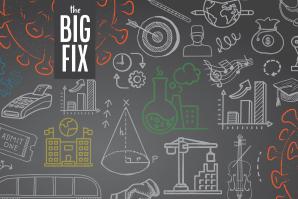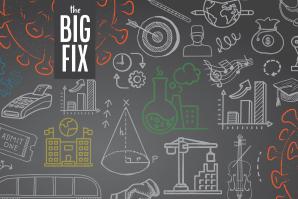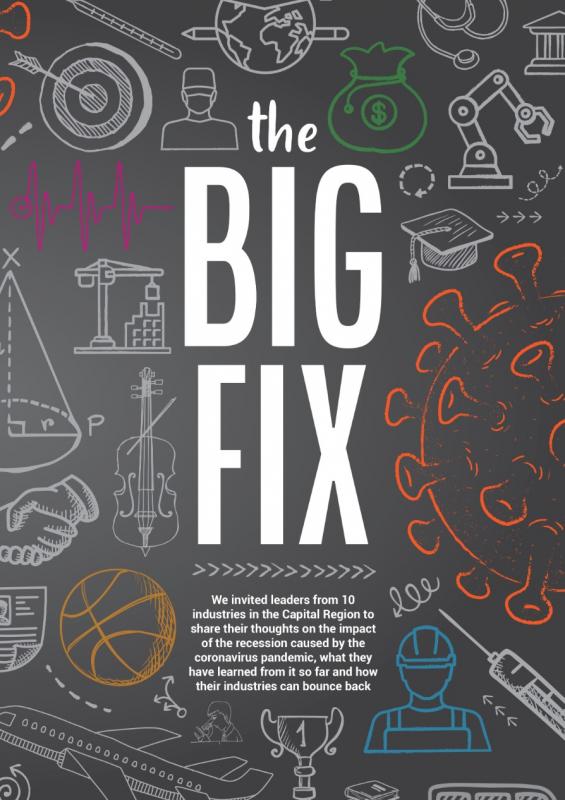(Photo courtesy of Evan Schmidt)

It’s only been a matter of months, but life can already be characterized as before and after COVID-19. It has touched all areas of life, the workplace chief among them. Who knew that our region’s major institutions, like educational systems, could go remote in the span of a few weeks? Who imagined that we could lose such a significant portion of jobs across major sectors, like hospitality, retail and food service? As we contemplate how to carry on post-COVID, we are challenged to think differently about the way we do work, the opportunities that will emerge, and our approaches to prosperity and growth.
Thinking differently about post-COVID life is a chance to reimagine and update our social, economic and workforce systems to be more agile, inclusive, efficient and responsive to the needs of people. Now is a time of significant change — we must not let the massive disruptions we are facing go to waste. Instead, we need to use this moment to reimagine our future.
These challenges are top of mind in my new role as Valley Vision’s CEO. Based on our years supporting our region’s workforce system, four priorities are clear as we contemplate needed changes to the ways we prepare our workforce and develop our economy.
Prepare for Accelerated Automation
Automation and other technology trends already in motion will only gain momentum as the pandemic reshapes the economy and ways of doing work. As businesses recover, employers will be more likely to look for efficiencies by replacing human capacity with technology. A recent report, “Automation Risk for Jobs in the Capital Region,” conducted by Valley Vision and the North/Far North Center of Excellence for Labor Market Research, hosted by Los Rios Community College District, found that 32 percent of the 1.2 million jobs in the region are at high risk of automation.
As detailed in the report, high-risk automation jobs overwhelmingly are low wage and are filled by women and people of color. Additionally, sectors like food and retail hit hard by COVID-19 are also at highest risk of loss of jobs due to automation. Creating recovery responses that address increasing automation and digitalization of jobs will be critical.
Develop Strategies Around Workforce Needs
First, the health of our businesses is critical to the health of our communities. The Sacramento region has laid out strategies for supporting our high-growth sectors and promoting inclusive economic growth through our regional plan, Our Path Forward: The Prosperity Strategy. Without a collaborative, supportive effort toward recovery for our businesses, our communities cannot thrive. Second, we must consider the diverse needs of workers. Because automation trends are accelerating, jobs that come back post-COVID won’t be the same as the ones lost. Programs that retrain and upskill workers are critical to ensure a pathway from old jobs to new jobs that are more highly digitized and more automated.
Additionally, a study by Becker Friedman Institute suggests up to 42 percent of lost jobs may never come back, due primarily to harms of recession, increased automation, and changing demand and perspectives as a result of COVID-19. The reality is some people won’t have jobs to return to post-recession and will need support. Universal-income-type programs — or programs that guarantee monthly income — should be considered. Finally, we must teach 21st-century skills in our K-12 schools and work to close disparities in educational outcomes. We need education to encourage curiosity, perseverance and adaptability while celebrating the uniqueness of diverse children.
Center Efforts on Inclusion
We can’t reimagine systems using old and prejudicial lenses that deny some people the ability to reach their potential. Now is a moment to reform education, workforce, social and other systems. We must listen, learn and act as a whole community in ways that create new systems of inclusion that can close divides.
Set Audacious Goals
At this time of change and challenge, we must create goals that unify us and that we can rally around. For example, digital skills and digital inclusion have been identified as a strategy for social mobility by the Brookings Institution. As a region, we could make a commitment around a common set of future-focused digital-skill-attainment goals for students and adults, work to ensure that all students are certified in these skills, and all adults have access to them. This would prepare our communities for jobs and brand our region as home to a talented, future-ready workforce. These types of audacious goals can bring us together and create a clear path of action in these times.
Workplaces and workforce needs were already changing, and COVID-19 is intensifying and accelerating those changes. To meet the challenges, we must think differently about our future and aim for where we want to go rather than recreating where we have been.
–
Evan Schmidt is CEO of Valley Vision, a civic leadership organization focused on creating livable communities in the Capital Region. At Valley Vision since 2014, Schmidt leads collaborative and data-driven solutions to economic, social and environmental challenges. Schmidt has expertise in advancing research and initiatives in the future of work.
Stay up to date on the effects of the coronavirus on people and business in the Capital Region: Subscribe to the Comstock’s newsletter today.
Recommended For You

Waiting for Workers
Staffing agencies are ready to fill jobs as soon as companies begin rehiring
The combined region of Sacramento, Placer, El Dorado and Yolo counties lost 800 professional and business services jobs between February and March. Those job losses have affected local staffing agencies.

Learning to Pivot
New college grads are adapting to an economy and job market hard hit by the coronavirus pandemic
As college seniors finished their classes online, the impact of the coronavirus pandemic complicated their job prospects.

California Manufacturers Are Innovating for the Pandemic
In our series, The Big Fix, industry experts explore how the region can rebound from the coronavirus shutdown
The pandemic has revealed how manufacturers can pivot and innovate quickly to make needed products, keeping the critical supply chain going.

Infrastructure and Workforce Will Help Attract Companies
In our series, The Big Fix, industry experts explore how the region can rebound from the coronavirus shutdown
Developers are working to strengthen the Capital Region’s competitive advantages and redefine its value proposition for businesses looking to move or expand.




